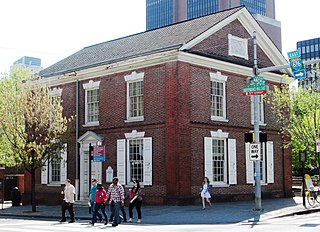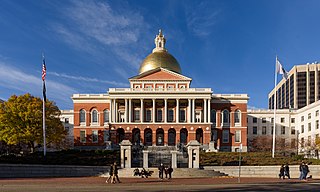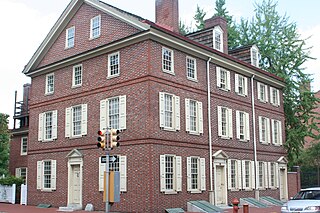 W
WFederal-style architecture is the name for the classicizing architecture built in the newly founded United States between c. 1780 and 1830, and particularly from 1785 to 1815. This style shares its name with its era, the Federalist Era. The name Federal style is also used in association with furniture design in the United States of the same time period. The style broadly corresponds to the classicism of Biedermeier style in the German-speaking lands, Regency architecture in Britain and to the French Empire style.
 W
WBoston Light is a lighthouse located on Little Brewster Island in outer Boston Harbor, Massachusetts. The first lighthouse to be built on the site dates back to 1716, and was the first lighthouse to be built in what is now the United States. The current lighthouse dates from 1783, is the second oldest working lighthouse in the United States, and is the only lighthouse to still be actively staffed by the United States Coast Guard, being automated in 1998 though there is still a keeper acting as tour guide. The structure was designated a National Historic Landmark in 1964.
 W
WCarpenters' Hall is the official birthplace of the Commonwealth of Pennsylvania and a key meeting place in the early history of the United States. It is in Independence National Historical Park in Philadelphia, Pennsylvania.
 W
WThe City Tavern is a late-20th century building designed to be the replica of a historic 18th-century building which stood on the site. It is located at 138 South 2nd Street in Philadelphia, at the intersection of Second and Walnut Streets. The original 18th century building was frequented by the Founding Fathers of the United States and other distinguished people. High-profile events took place there, including the first anniversary celebration of the 4th of July.
 W
WCongress Hall, located in Philadelphia at the intersection of Chestnut and 6th Streets, served as the seat of the United States Congress from December 6, 1790 to May 14, 1800. During Congress Hall's duration as the capitol of the United States, the country admitted three new states, Vermont, Kentucky, and Tennessee; ratified the Bill of Rights of the United States Constitution; and oversaw the Presidential inaugurations of both George Washington and John Adams.
 W
WThe President, Directors and Company, of the Bank of the United States, commonly known as the First Bank of the United States, was a national bank, chartered for a term of twenty years, by the United States Congress on February 25, 1791. It followed the Bank of North America, the nation's first de facto central bank.
 W
WThe Free Quaker Meetinghouse is a historic Free Quaker meeting house at the southeast corner of 5th and Arch Streets in the Independence National Historical Park in Philadelphia, Pennsylvania. It was built in 1783, and is a plain 2 1⁄2-story brick building with a gable roof. The second floor was added in 1788. The building was moved about 30 feet to its present site in 1961, to allow for the widening of Fifth Street.
 W
WThe Hammond–Harwood House is a historic house museum at 19 Maryland Avenue in Annapolis, Maryland, USA. Built in 1774, is one of the premier colonial houses remaining in America from the British colonial period (1607–1776). It is the only existing work of colonial academic architecture that was principally designed from a plate in Andrea Palladio's I Quattro Libri dell'Architettura (1570). The house was designed by the architect William Buckland in 1773–1774 for wealthy farmer Matthias Hammond of Anne Arundel County, Maryland. It was modeled on the design of the Villa Pisani in Montagnana, Italy, as depicted in Book II, Chapter XIV of Palladio's work. It was designated a National Historic Landmark in 1960, and is now managed by a non-profit organization as a museum.
 W
WIndependence Hall is the building where both the United States Declaration of Independence and the United States Constitution were debated and adopted. It is now the centerpiece of the Independence National Historical Park in Philadelphia, Pennsylvania and is a UNESCO World Heritage Site.
 W
WThe L'Enfant Plan for the city of Washington is the urban plan developed in 1791 by Major Pierre (Peter) Charles L'Enfant for George Washington, the first President of the United States.
 W
WThe Massachusetts State House, also known as the Massachusetts Statehouse or the New State House, is the state capitol and seat of government for the Commonwealth of Massachusetts, located in the Beacon Hill neighborhood of Boston. The building houses the Massachusetts General Court and the offices of the Governor of Massachusetts. The building, designed by architect Charles Bulfinch, was completed in January 1798 at a cost of $133,333, and has repeatedly been enlarged since. It is considered a masterpiece of Federal architecture and among Bulfinch's finest works, and was designated a National Historic Landmark for its architectural significance.
 W
WThe Nathaniel Bowditch House, sometimes called the Bowditch-Osgood House and the Curwen-Ward-Bowditch House, is a historic house and National Historic Landmark at 9 North Street in Salem, Massachusetts. With a construction history apparently dating to 1759–60, the house is distinctive as having been owned by three families important in the maritime history of Salem. Its landmark designation in 1965 stems from its association with Nathaniel Bowditch (1773–1838), the founder of modern navigation, who lived here from 1811 to 1823. The house now serves as the headquarters of Historic Salem, Inc., which was responsible for its rescue from demolition and eventual restoration.
 W
WOld City Hall located at Chestnut Street at 5th Street in the Independence Hall complex of Independence National Historical Park in Center City, Philadelphia, was built in 1790–91 in the Federal style. The architect was David Evans, Jr.
 W
WPhilosophical Hall is a historic building at 104 5th Street in Center City, Philadelphia, Pennsylvania, US. Located near Independence Hall, the building has, for over 200 years, been the headquarters of the American Philosophical Society. It was designated a National Historic Landmark in 1965 for its association with that organization.
 W
WThe Residence Act of 1790, officially titled An Act for establishing the temporary and permanent seat of the Government of the United States, is a United States federal statute adopted during the second session of the First United States Congress and signed into law by President George Washington on July 16, 1790. The Act provides for a national capital and permanent seat of government to be established at a site along the Potomac River and empowered President Washington to appoint commissioners to oversee the project. It also set a deadline of December 1800 for the capital to be ready, and designated Philadelphia as the nation's temporary capital while the new seat of government was being built. At the time, the federal government was operating out of New York City.
 W
WThe Ropes Mansion, also called Ropes Memorial, is a Georgian Colonial mansion located at 318 Essex Street, located in the McIntire Historic District in Salem, Massachusetts. It is now operated by the Peabody Essex Museum and open to the public.
 W
WThe Betsy Ross House is a landmark in Philadelphia purported to be the site where the seamstress and flag-maker Betsy Ross (1752-1836) lived when she is said to have sewed the first American Flag. The origins of the Betsy Ross myth trace back to her relatives, particularly her grandsons, William and George Canby, and the celebrations of the Centennial of 1876. Evidence for the precise location of Ross' home came from verification provided by several surviving family members, although the best archival evidence indicates the house would have been adjacent to the one that still stands today as The Betsy Ross House. Although the house is one of the most visited tourist sites in Philadelphia, the claim that Ross once lived there, and that she designed and sewed the first American flag, sometimes called the Betsy Ross flag, are considered false by most historians.
 W
WThe Dolley Todd House or Dolley Todd Madison House in Philadelphia, Pennsylvania is a house once owned by Dolley Madison. Madison lived in the home with her first husband John Todd Jr. prior to his death in 1783. It is located on the northeast corner of 4th and Walnut Streets in the Society Hill neighborhood of the city.